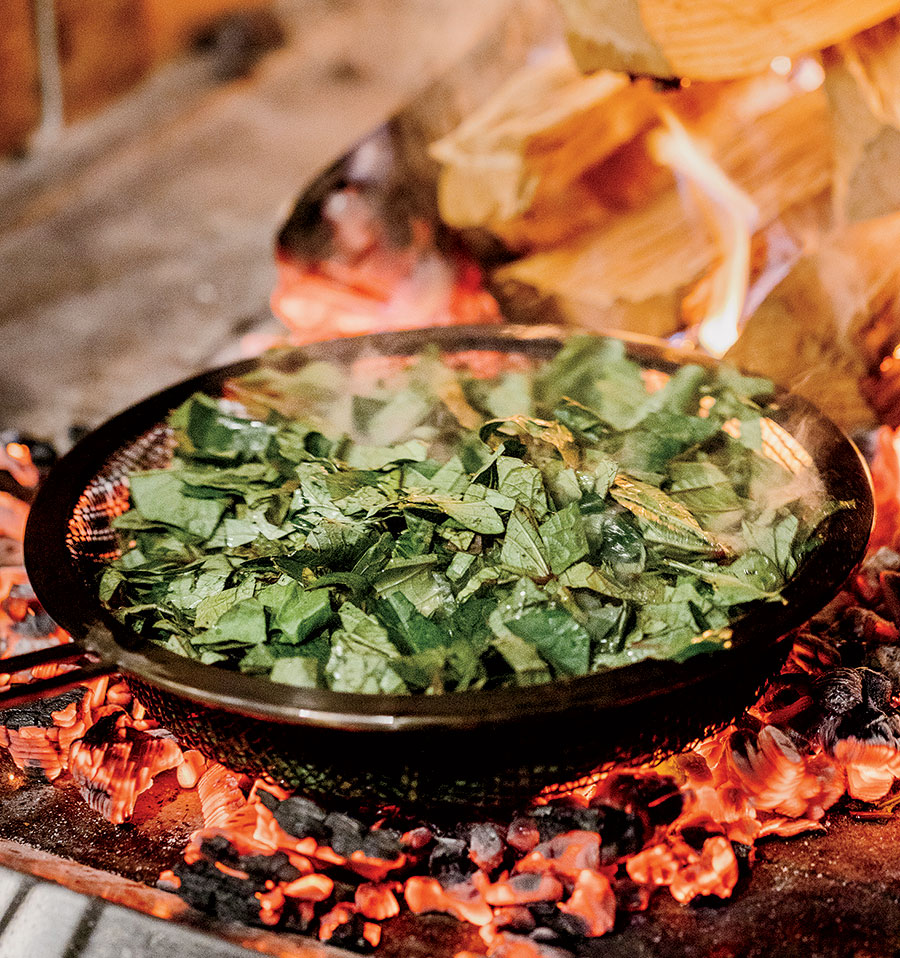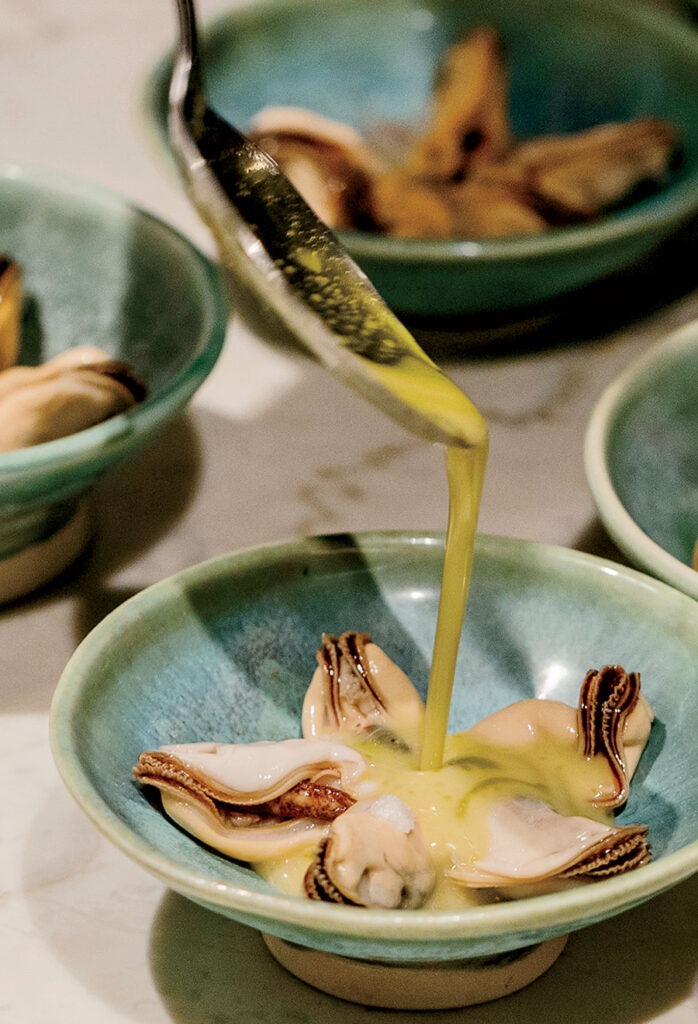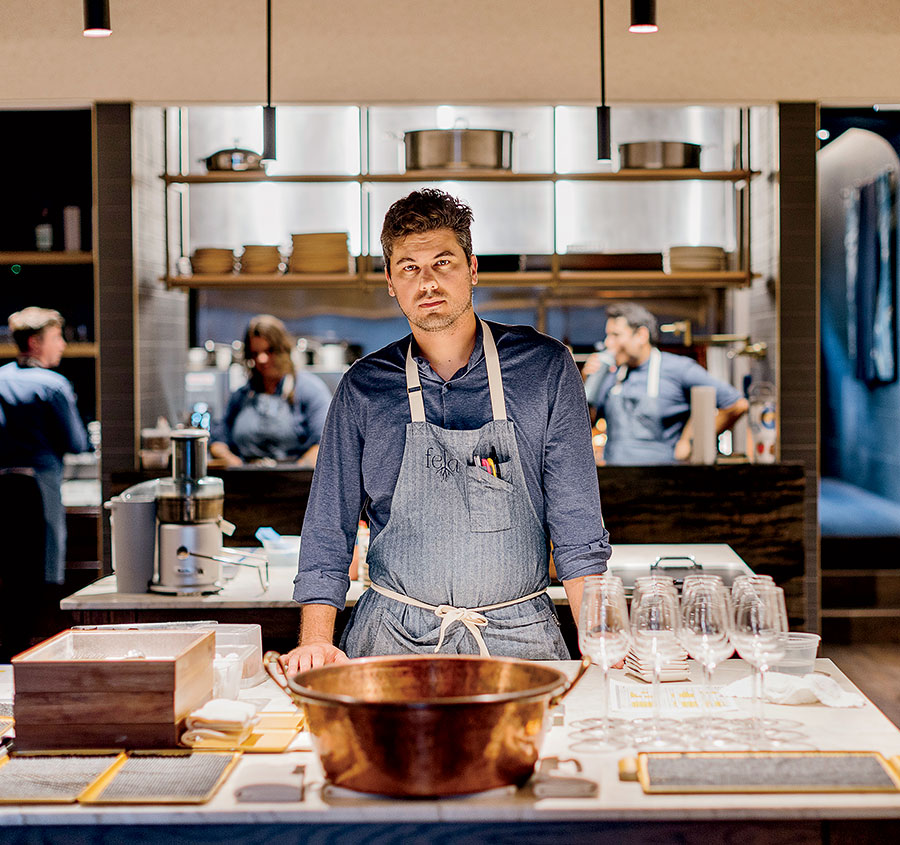For more than two years, Jake Potashnick has documented his thoughts on food on the popular TikTok account @notyetachef, where his perspective has been that of a hardworking cook hungry for knowledge. More than 85,000 followers have joined him in restaurant kitchens, on dining travels from San Sebastián to Zanzibar, and in his home, where he shows off his toys — like a Pacojet that can slice an ice block so finely it becomes ice cream.
Whatever the subject, Potashnick is direct, friendly, and more than a little cocky; he never hesitates to spout off with an opinion. His pithy videos have delved into topics as diverse as Thomas Keller’s famous Oysters and Pearls dish or why a minor character on The Bear was based on Charlie Trotter. He has also shared his impressive résumé. A Chicago native who’s been obsessed with food since he was a kid, he earned double-dip degrees from the Culinary Institute of America and the Cornell School of Hotel Administration and worked at famous places in Europe and Japan — most notably the Michelin-starred Ernst in Berlin. All this before he turned 30.
Over the past year, his videos have mainly focused on one subject: the run-up to opening his first restaurant, Feld, in Ukrainian Village. Things got more esoteric but no less interesting when he began discussing the merits of different reservation platforms and the high cost of a grease trap. He also began to share more of his culinary philosophy, which he dubbed “relationship to table.” Farmers, fishers, ranchers, and cheesemakers — he wants you to know the people who supply your food. He would bring these ingredients together in a nightly changing meal consisting of 30-some small bites of the season’s best. Then Feld opened. Hoo boy.
Not surprisingly, people on social media rushed in with hot takes, and they were not good. Commenters on Reddit talked of how the food was underseasoned and underwhelming. Folks who had not eaten at Feld derided the simplistic plating with mean jokes. Potashnick tried sticking up for the restaurant and came off sounding defensive. Soon reviewers from online publications stormed the gates, and their write-ups were dismal.
I wish I could channel the sangfroid of Yoda and declare, “Give a shit about all this, I do not.” But I can’t. Potashnick, now 31, has all along been proposing a new kind of food discourse, and it has arrived, though not in the way he had imagined.

His cooking offers a radically different approach to fine dining, one where unadorned bites let the flavors talk, much like courses at a sushi omakase. His presentations also take a cue from Japan, with dishes that are set on or in custom vessels for an aesthetic that is experiential rather than Instagrammable. His early detractors either didn’t like his approach or found he couldn’t deliver on it. Their opinions are certainly valid, though I formed my own over two visits.
Is Feld worth your attention? After my second visit, I’d say yes. The first meal felt like a mishmash of one-bite oddities with a few bright moments that hinted at potential. Potashnick was clearly still finding his footing on the $195 tasting menu. The second meal had more shape and buoyancy, filled with ideas that made me smile and flavors that encouraged me to stop and appreciate the moment. There were missteps (maybe a few too many), but these are bound to happen on a menu that changes daily, and I happily hopped on this distinctive ride.
Go with an open mind and let Feld upend your notions of fine dining, starting with the unusual layout of the space. You walk through the foyer past a display of the day’s ingredients. Beyond lies the dining room, where the 18 to 20 guests occupy tables hugging the walls so they all face a central plating area and one another. (This makes a fun game of guessing their stories.) The kitchen lies at the far end, where an open hearth blazes.
The meal kicks off with a cup of chilled vegetable broth, perhaps tomato and lemon verbena, then moves at a fast clip, with cheerful chefs popping by every few minutes with a little something-something. A salty tile of cured ham. A slow-grilled baby artichoke with a texture I had never before experienced. If this meal were an album, it would be 69 Love Songs by the Magnetic Fields.
The menu eases into little bowlfuls you eat with chopsticks. These typically contrast two ingredients, and some are bliss machines, such as heat-blistered sweet potato greens with luscious goat butter emulsion, or grilled corn over cured egg yolk.

The third stage of the dinner brings knives, forks, and plates of meaty things. These were not good at my first meal — I unfondly recall fatty, unseasoned pork belly in a sauce like glue — but kind of brilliant when I returned. Potashnick takes a whole roasted lobe of foie gras from Au Bon Canard, a farm in Minnesota, on a tour of the dining room (it ain’t a looker), then returns it as a sublime slice topped with poached green grapes. When I’m served a fat slice of a Mr. Stripey yellow tomato, exquisitely dressed and presented as a main event, it’s a moment when I think Chicago needs to pay attention.
Dessert showcases Potashnick’s epic sweet tooth. On the second visit it was a volley of deliciousness, starting with melon and tomato sorbets. It was then onto a bee pollen mousse with honey cream, oats, and lavender and a second mousse made from a brand of chocolate (Svenska Kakaobolaget) that Potashnick got to know while working in Sweden. A basket of fresh iced fruit offered the ideal last bite.
At the first meal, the desserts were the cherry on an undercooked cake. One involved buttermilk that tasted flat-out spoiled. There were too many flaws, like potatoes that had undergone a complex cooking process that resulted in a dead ringer for raw. Partway through, my spirit of hopeful anticipation was replaced by the feeling I was a DMV inspector on a driving test marking off demerits. Sitting in that room looking at all the other people facing us began to feel less like theater in the round and more like a panopticon. The storytelling also became counterproductive. The more the servers told me about the terroir in a plum, the more my palate went, “Huh, don’t see it.” Potashnick needs to kill his darlings.
What do you drink with all this? Hard question. The talented sommeliers put together an exciting and fairly priced ($125) pairing one night. I loved the lineup, including a reserve Pinot Gris from the great Alsatian producer Albert Boxler, but it was almost laughable how often the wines clashed with the food. The menu has too many zigzags. A bottle of Grüner Veltliner was a better option, thanks to the bright acidity and nuance to meet the food where it is.
If my descriptions of the two meals sound dramatically different, you should’ve heard the postmortems. After the first, we focused on the half-baked ideas and high price. The second time I went with a different friend, and once outside she said, “You know what? That was fun.” It was! She and I have eaten a lot of tasting menus together, and this one was much livelier and more interactive than others with art on the plate. I wish Potashnick would offer a simpler or à la carte menu during the week so that more people could try his thoughtful cooking. He’s got a lot to say about dining in Chicago today, and I encourage more people to come hear it.



